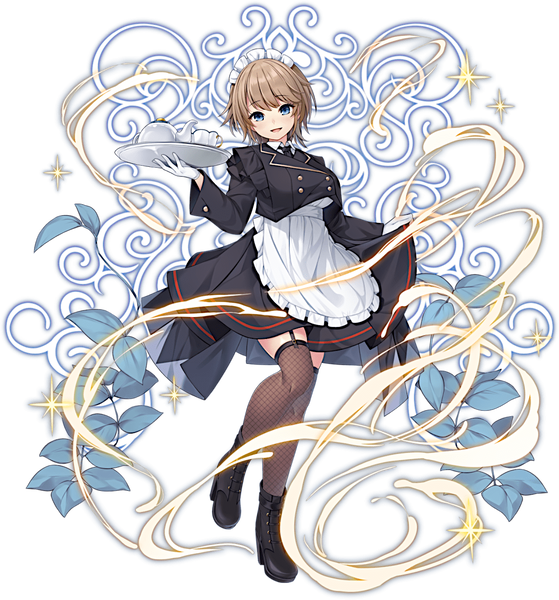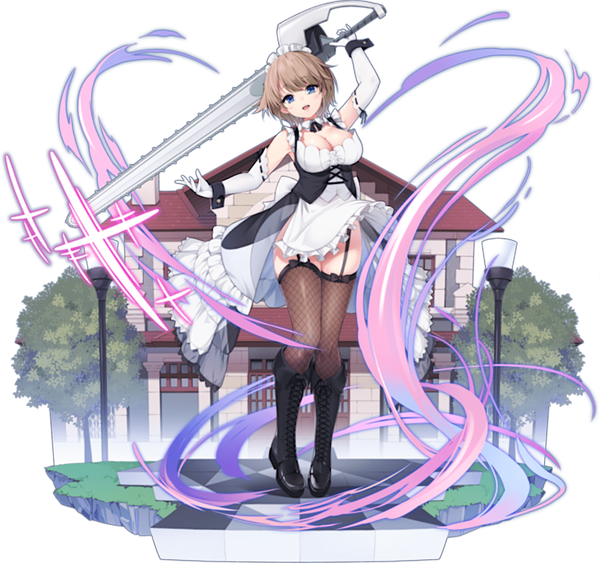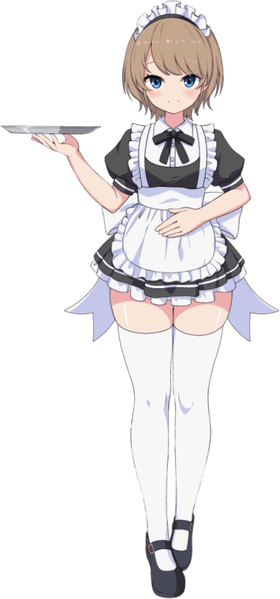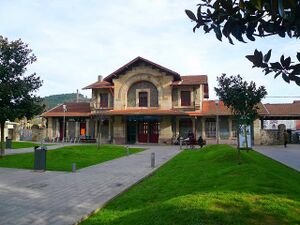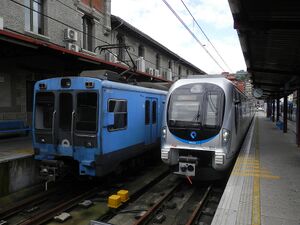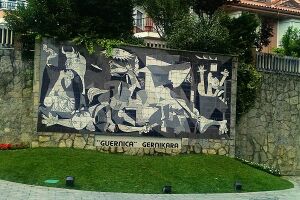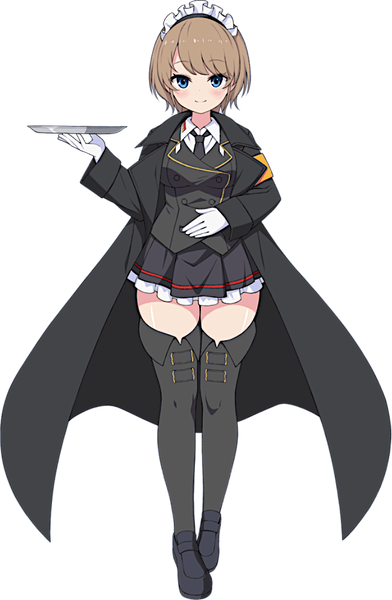
Guernica
| Guernica | |||||
|---|---|---|---|---|---|
| Japanese Name | ゲルニカ | ||||
| Weapon | |||||
| Race | Human | ||||
| Nationality | |||||
| Birthday | April 26 | ||||
| Constellation | Taurus | ||||
| Talents | Can produce many artistic paintings quickly | ||||
| Likes | Loving and devoting to her master, Painting, Demolition work, Doves | ||||
| Dislikes | Separation from loved ones, Restrictions on works of art | ||||
| Strengths | Good at housework, Maintenance, management and decoration of buildings | ||||
| Weaknesses | Taunts others to do things they don't like | ||||
| Hobbies | Painting, Importing and molding materials, Maintenance, management and demolition of buildings | ||||
As you may know. I am Milady Frankfurt's servant. But because I love that tyrannical shitfaced little masochist brat, her father became jealous of me and wanted to dispose of me, and so I fled... After that, I found myself as a Revolutionarios agent, which was an extremist militant organization. But don't worry. From the bottom of my heart, I pledge allegiance to shithead Conductor now♪
Layers
| Icon | Title | Release Date | Where to Obtain |
|---|---|---|---|
| [Beloved Sharp-Tongued Servant] Guernica | 2023 February 22 | [Altar of Judgement - Big Jizo Hoptoad] Event Reward | |
| [Showing Love With Venom] Guernica | 2023 July 31 | [Snow Fairy and the First Excursion] Pick Up Gacha, Premium Gacha | |
| [Twisted Love] Guernica | 2023 February 14 | [Sharp-Tongued Maid and the Female Pirate] Limited Gacha |
Skills
Profile
Guernica is formerly an agent leading the "Revolucionarios" faction, unleashing the rebellion against Frankfurt's father, called the Dictator. She is also Frankfurt's former and current maid.
Event Story
| Guernica's Skyscraper |
|---|
|
Guernica's first appearance is in Skyscraper's Guernica as an antagonist confronting her former master Frankfurt in a rebellion. (WIP) |
Trivia
- Guernica's birthday is the Bombing of Guernica during the Spanish Civil War in 26 April, 1937. Her namesake train station was also bombed at the time.
- Guernica's love for artwork and painting and her revolution theme in the Skyscraper's Guernica event strongly references the art of the same name, Guernica, and the painting's artist, Pablo Picasso. Her constellation being Taurus and the bull in Picasso's painting may also be a coincidence.
- Her liking for doves is a reference to doves being a symbol of peace, largely due to Picasso's 1949 lithographic work.
- The building in the background of [Twisted Love] is the Guernica station in Basque, Spain.
- Sierra Matadora is Spanish for "Kill Saw".
- The design of the white swirls in [Showing Love With Venom] is based off the interior wall design of Guernica station.
Counterpart
Guernica Station is a railway station in Gernika, Basque Country, Spain. It is owned by Euskal Trenbide Sarea and operated by Euskotren. It lies on the Urdaibai line, located in the municipality of Gernika-Lumo, next to the former factory and the building that is now the Astra youth center. The station opened as the northern terminus of the Amorebieta-Gernika line on 13 August 1888. The station building was enlarged in 1893. The station was destroyed during the civil war when the town was bombed, and had to be rebuilt. In 1973, together with the electrification of the line, the tracks on the station and the depot were reformed. The station building was overhauled in 1990.
The station buildings were built with a two-story central nave and a single-story volume on the sides. It was designed by Pablo de Alzola and Luis de Landecho and was considered a model for the main stations of the La Robla railway. In 1893, a second floor was added to the side volumes, in order to establish offices. In addition to the main building, the station's facilities were equipped with a 500 m² cargo warehouse, a cargo loading dock, a 340 m² carriage houses, a 213 m² carpentry workshop, a 500 m² rolling stock maintenance workshop, a 220 m² locomotive tank, a weight scale and a rotating bridge.
When diesel locomotives were introduced on the railway, fuel tanks were installed at the station, and when the railway was electrified, the main electrical substation was also located here. The station had a total of three passenger tracks, one freight track, two carriage tracks and three workshop tracks. As a result of the bombing of Gernika, the building was destroyed, and only the walls remained standing. After the reconstruction of the train station, the area of the second floor was reduced. In 1973, along with the electrification of the railway, the workshop and coach buildings were replaced, with the construction of a new pavilion with four railway tracks and the location of the electrical substation around it.
In 1990, the electric catage system was installed, to carry out the maneuvers of the railways in an automatic way. The cargo warehouse building has been converted into a cultural information office under the Gernika City Council. On December 4, 2017, new ticket vending machines were installed at the station, meeting accessibility standards for people with reduced mobility, a T-shaped magnetic loop for people with hearing disabilities, Braille screen printing on all interaction elements (buttons, ticket booths, etc.), and blind and visually impaired people. which have sales software tailored to people who have. On July 5, 2018, the new comprehensive Customer Service Office of the Bizkaia Transport Consortium was opened. Wikipedia
On 26 April 1937, the Basque town of Guernica (Gernika in Basque) was aerial bombed during the Spanish Civil War. It was carried out at the behest of Francisco Franco's rebel Nationalist faction by its allies, the Nazi German Luftwaffe's Condor Legion and the Fascist Italian Aviazione Legionaria, under the code name "Operation Rügen". The town was being used as a communications centre by Republican forces just behind the front line, and the raid was intended to destroy bridges and roads. The operation opened the way to Franco's capture of Bilbao and his victory in northern Spain.
The attack gained controversy because it involved the bombing of civilians by a military air force. Seen as a war crime by some historians, and argued as a legitimate attack by others, it was one of the first aerial bombings to capture global attention. The number of victims is still disputed; the Basque government reported 1,654 people killed at the time, while local historians identified 126 victims (later revised by the authors of the study to 153). A British source used by the USAF Air War College claims 400 civilians died. Soviet archives claim 800 deaths on 1 May 1937, but this number may not include victims who later died of their injuries in hospitals or whose bodies were discovered buried in the rubble.
The bombing is the subject of the anti-war painting Guernica by Pablo Picasso, which was commissioned by the Spanish Republic. It was also depicted in a woodcut by the German artist Heinz Kiwitz, who was later killed fighting in the International Brigades, and by René Magritte in the painting Le Drapeau Noir. The bombing shocked and inspired many other artists, including a sculpture by René Iché, one of the first electroacoustic music pieces by Patrick Ascione, musical compositions by Octavio Vazquez (Gernika Piano Trio), René-Louis Baron and Mike Batt (performed by Katie Melua), and poems by Paul Eluard (Victory of Guernica), and Uys Krige (Nag van die Fascistiese Bomwerpers, English translation from the Afrikaans: Night of the Fascist Bombers). There is also a short film from 1950 by Alain Resnais titled Guernica.
Map
Gallery
- Pages using Tabber parser tag
- Pages using DynamicPageList3 parser tag
- Weapon Sword
- Human
- Eisengrad
- Taurus
- Element Cut
- Element Fire
- Element Dark
- Train Knights
- Spain

